For charitable organizations, fundraising is not just a requirement, it’s a crucial necessity. That is why such a field as email marketing for nonprofit organizations is the perfect tool for this. In this guide, we dive deeper into the important role email marketing plays in engaging donors, increasing donations, and expanding your overall reach. With practical strategies and actual examples, this blog post serves as an ultimate guide for nonprofits to maximize their potential.
Does Nonprofit Email Marketing Exist?
Just like e-commerce companies, nonprofit projects like funds and charities also benefit from email marketing. Their overall goals may differ, but the strategies remain similar. Nowadays, the use of it by nonprofits is only growing.
The outbreak of a full-scale war in Ukraine caused a burst of fundraising due to the opening of many campaigns to help Ukraine. Here’s how the CEO of our company and a highly qualified email marketing expert, Andriy Boychuk, highlights that nonprofit companies could also benefit from it:
On February 24th, 2022, a full-blown war broke out in Ukraine following Russia’s Invasion. This event became a catalyst for me to join Razom for Ukraine, the largest Ukrainian nonprofit in the US. With a professional background in email marketing, I initially thought my skills wouldn’t be as vital compared to immediate relief efforts. However, I soon realized the immense potential of email marketing in helping nonprofits fulfill their mission.
Email marketing is mostly perceived as a tool to increase commercial revenue, without considering that it can also be useful for organizations that do not have revenue as a primary goal. Using it for nonprofits can help with engaging people, donors, and supporters, and spreading the word about important charitable causes.
Importance of Email Marketing for Nonprofits
Email marketing is an essential channel for attracting and retaining donors. It helps nonprofit organizations raise funds, communicate with their audiences, and ensure a steady stream of resources for their missions. It is also worth noting that for nonprofits, using this way of attracting traffic is a significant saving compared to other traffic channels.
Savings are not the only reason, though, as this is the way to build long-term relationships with subscribers, and subscribers will become aware of events and developments within the company. Whether it’s e-commerce or nonprofit, the principles remain the same, to build a meaningful connection with your audience and foster relationships that encourage ongoing support.
Our agency doesn’t work with nonprofits unless you sell physical goods and have an online store. So this content is specifically designed to help nonprofit teams improve and make their efforts more effective.
If you don’t want to read a bunch of information from this article but prefer a video format presented by an expert, we’ve created a video for you. In this video, Anthony Aurrichio, charity: water’s Retention Marketing Manager, discusses lead magnet ideas for nonprofits, ideas for custom email automation, and how to use email marketing to encourage bigger donations and much more.

Do’s and Don’ts in Growing Nonprofit Email Marketing List
To add some expertise to this article, we did some research and investigated the 10 largest nonprofits in the US, as well as some smaller ones that caught our attention. How do they get subscribers? Or don’t they? We present to you the list of the 10 largest nonprofit organizations in the United States according to Forbes.
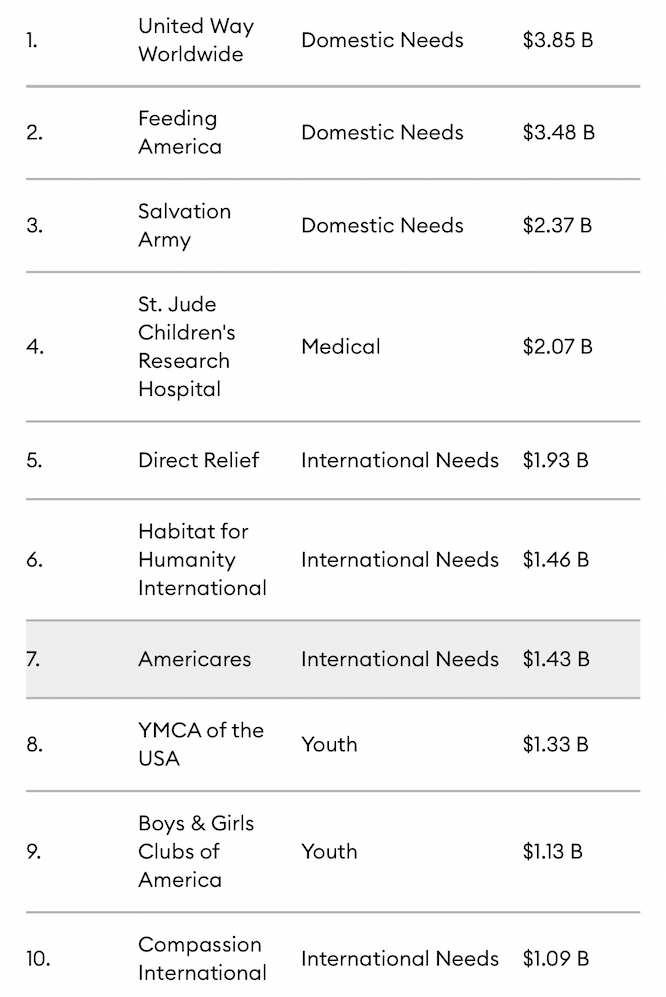
Useful Tips and Methods
There are many ways to grow your email list, and we’ve even created a podcast on the 8 best ways to do it.
Having received these tips, now we need to discuss why it’s important to receive emails. People don’t buy or donate at first sight. They need some empathy and education about your organization. They need to feel comfortable donating to your organization. If you don’t collect visitors’ email addresses when they come to your site, this potential donor is lost. If you do collect their email addresses, you have 100+1 opportunities to ask them for a donation, thereby extending your relationship with them.
Growing your mailing list is a fundamental step in leveraging the power of email marketing. After our research of the 10 largest nonprofits in the US, we analyzed several effective ways nonprofits can grow their email lists:
- Signup form in the footer: Add a signup form to the footer of your website. It’s an easily accessible place where people often expect to find subscription options.
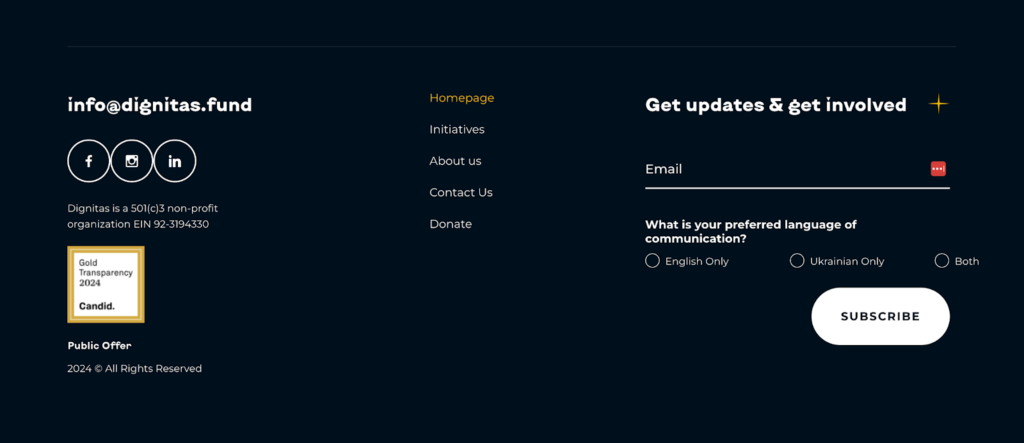
- Signup forms on relevant pages: Pages like “About Us” or “Our Mission” are ideal for signup forms because visitors will already know about your organization.
- Signup link on social: Nonprofits are required to have social media channels, and in turn, the descriptions of each social channel, such as Instagram, Twitter, and Facebook, should contain an organic link to the email newsletter.
- Signup on the homepage: Add a signup section to your homepage with a simple message like “Sign up for updates”.
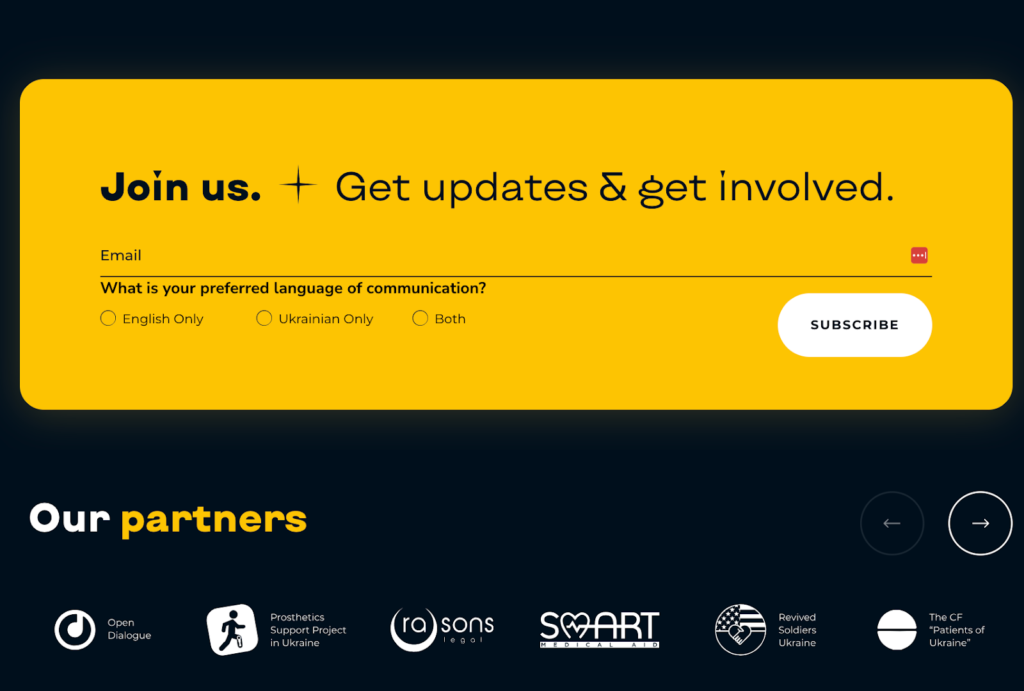
- Intent-to-leave pop-up: If a visitor is about to leave your site, offer them an attractive pop-up to get their email address.
- Donation pop-up: If a visitor is on your donation page but leaves without donating, show them another intent-to-leave pop-up to collect their email address.
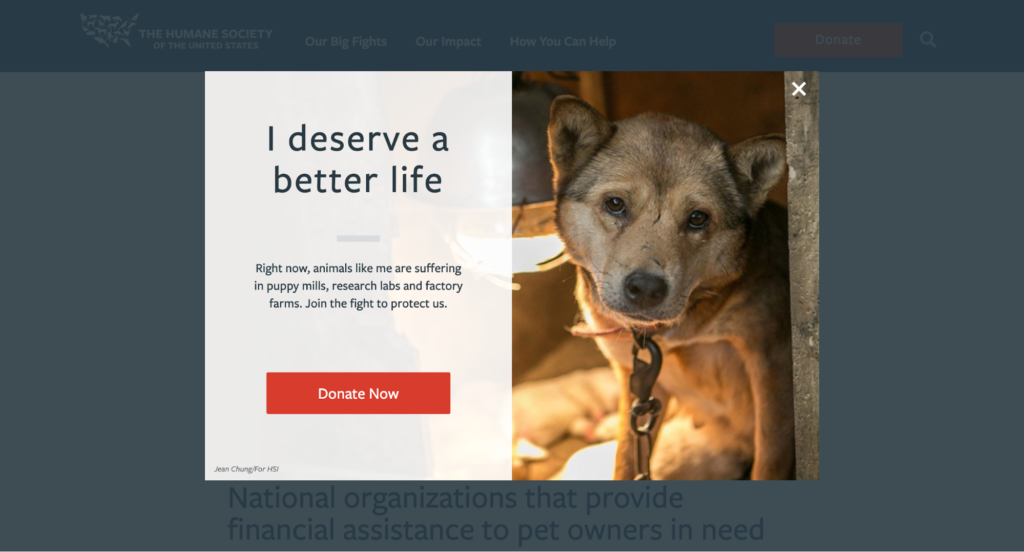
For more tips, you can listen to our podcast, Email Einstein, with simple tips for building your massive email list.
Mistakes You Should Avoid
Now that you’ve learned the most effective ways to grow your email list, we’ll return to our research and see what methods the largest nonprofits use. We were very surprised and disappointed by the results of our research:
- In 6 of the 10 largest companies, we were unable to subscribe to their newsletter or updates. Some had a simple subscription form in the footer.
- In the rest, it took us a long time to find the subscription button. Only one organization had something like a lead magnet.
- Some organizations immediately had a pop-up asking for donations. This technique is extremely inefficient. The user has just arrived and hasn’t yet had time to learn about the organization and its goals, and they are already being asked to invest. Of course, this will put off many of the possible clients.
- A practice similar to instant pop-ups can be spamming your subscribers. Never spam your subscribers, as this will not lead to anything good. It is not allowed to send newsletters to people who have not willingly subscribed to your newsletter.
- Another mistake made by inexperienced nonprofits is the lack of metrics. Metrics such as open rate, CTR, and so on, are mandatory. It is also important not to forget about the use of A/B testing.
- The final common mistake is the lack of optimization. According to researches, the majority of users open emails on mobile phones, which is why it’s important not to forget about optimizing for mobile devices.
Strategies for Nonprofit Email Marketing
Before moving on to the strategies, we should note that email marketing can be broadly divided into two categories each of which should also be present:
Create Campaigns and Automations for Nonprofit Email Marketing
- Campaigns (Newsletters)
Nonprofits often excel in creating informative, educational newsletters with clear calls to action. This strategy arises from the fact that nonprofit organizations cannot attract spending with various discounts, and qualified nonprofit groups rely on interesting newsletters with engaging descriptions and attractive images. Here are a few impressive newsletters from various nonprofit email marketing examples.
- Behavioral Triggered Emails (Automations)
These automated emails, though frequently overlooked by nonprofits, can be incredibly effective. Here’s an ideal automated email marketing strategy for nonprofits:
- Welcome Series
- Thank You Messages
- Win-Back Campaigns
- Donation Abandonment Reminders
- Sunset Emails
Create a Donation Match
Large retailers often organize promotions where a percentage of purchases goes to charity. For example, in Ukrainian companies, where each major brand donates a percentage to its own fund for drones, vehicles, etc. In case they don’t have their own charitable organization, they collaborate. Here’s a strategy for you: collaborate with large-scale commercial organizations to create mutual campaigns that will benefit them by increasing sales and bringing you additional donations.

Focus on Text-Based Emails
Text emails feel less formal and reduce image distraction by getting straight to the point. It’s also highly optimized, as it loads faster and is easily viewed on mobile devices. If you do use images, however, they should be of appropriate quality and convey the organization’s specific feelings, thoughts, and values. Emails with a lot of text are best used in conjunction with segmentation, as some of your audience will not be interested in reading a lot of information.

Implement Segmentation
Segmenting your newsletters is a very effective strategy that will definitely increase your performance. You can choose your own segments, from professional RFM to simple segments based on the subscriber’s location. Add personalization to the segmentation, such as a basic first name in emails, and you will see a positive result.
Create Your Storytelling Campaign
To get closer to your donors, implement storytelling with a motivating story that will generate more donations. Write stories about your fund’s journey, or inspirational stories from your top donors, staff, and organizational members.

Engage Existing and Potential Supporters
Most donors, whether they’re seasoned donors or first-time donors who are just looking for the right giving, need encouragement and appreciation to feel the significance of their giving. To create a greater sense of connection and engagement, you can feature donor testimonials or spotlights within your emails. Highlighting real contributors builds a sense of belonging and appreciation. It will inspire others to get involved and contribute.
Personalization for Recurring Donators
The importance of regular donors is invaluable and you need to show it, which is why they need special treatment as they are the backbone of your charity. Personalized emails for recurring donors help deepen their relationship with your organization.
Start by expressing gratitude by recognizing their previous achievements and impact. Provide specific information regarding details of how their ongoing contributions have helped advance your mission to show them the magnitude of their contribution.

Share Your Progress
Provide relevant information about the progress of your charity campaign to keep interested subscribers informed of your progress and to encourage those who have not yet contributed to help you reach a short-term goal. In such emails, also include some information about how your organization has impacted and improved the lives of certain people to show subscribers the value of their donations.
If you’re currently trying to reach a specific goal, encourage followers to help you reach it by sharing information such as the amount of funding you need to complete the campaign. This timely update may motivate more people to contribute as they see progress toward the goal.

Donate Option in Emails
Usually, a long donation process with a transition to the website and all the subsequent steps discourages potential donors. Simplify this activity by adding a streamlined donation form to your emails, which will increase the collection of donations even if they won’t be that significant. This strategy will especially help with more specific segmentation.
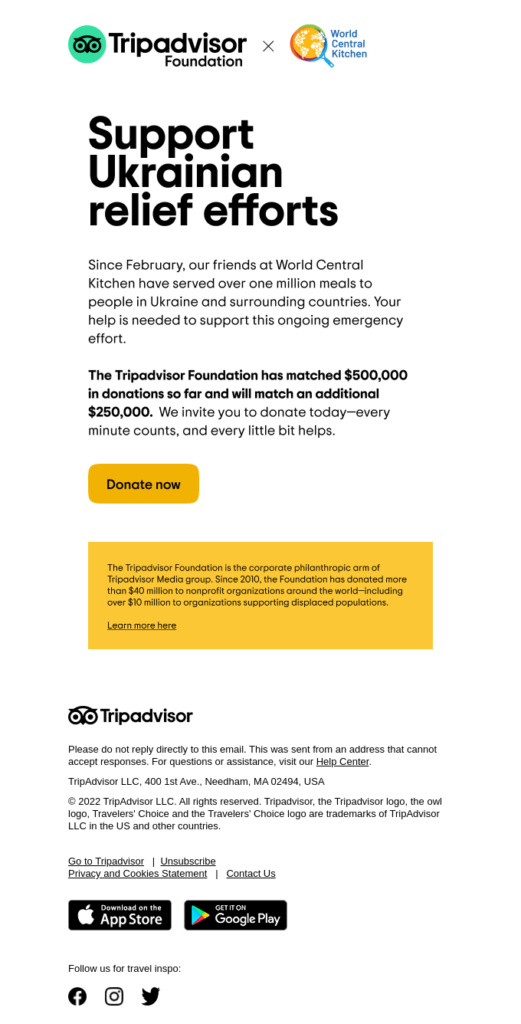
Expand Channels of Influence
To increase your visibility and encourage more donors, increase the number of your channels of engagement. After all, your audience may be different and use media other than email. Emails are a good outreach, but some customers appreciate direct contact. Expand your outreach strategy by adding direct mail with a QR code, creating social media accounts, and appearing on TV. For the best effect, aim for 7 channels of outreach.
Thank You for Donation Email
A good example of an email that will help you get closer to your donors and show them how important they are is a thank you email. If you specialize it for certain subscribers and describe how their support helped you, it will have a good effect and attract more interaction and donations from these members.
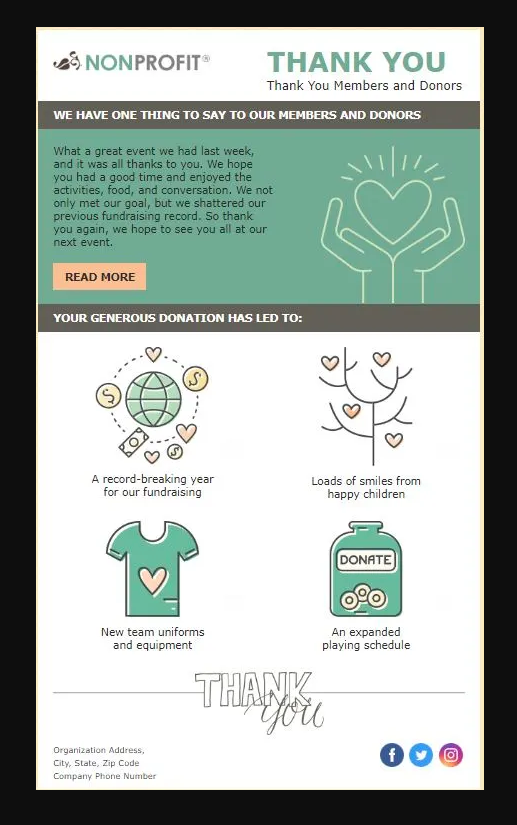
Best Email Marketing Software for Nonprofits
Email marketing is a vast and complicated marketing niche in which it is difficult to become a specialist on your own, without using professional software and some of its features, even with the help of many guides. The information we’ve provided is just the tip of the iceberg to help nonprofits understand their most common mistakes.
To develop your email campaigns to the maximum, we still recommend using professional platforms. For this purpose, we’ve compiled the top email marketing platforms for nonprofits. In the table, we have collected the most important information, including even the discount percentages for nonprofit organizations.
| Free Plan/Trial | Pricing | Discount for nonprofits | Best for | |
|---|---|---|---|---|
| Moosend | Yes (30-day free trial) | $9/month | 25% | Best overall email marketing service for nonprofits |
| Constant Contact | 14-day trial | $12/month | 20-30% | Event management |
| MailerLite | Yes | $10/month | 30% | Selling digital products |
| Mailchimp | Yes (limited) | $20/month | 15% | Pre-built automation journeys |
| AWeber | Yes | $15/month | 25% | Creating landing pages the easy way |
| GetResponse | 30-day trial | $19/month | 30-50% | Easy A/B testing |
| HubSpot | Yes | $20/month | 40% | Bigger organizations |
1. Moosend

Moosend is one of the best options among software for nonprofit organizations due to its affordable price and user-friendly interface. You will also find a library of over 100 ready-made templates that are easy to personalize and customize. The email editor interface does not require any coding experience. The platform provides you with in-depth, real-time analytics to monitor metrics like open rates and click-through rates so you can make data-driven decisions. With Moosend, you also get a 24/7 support team to help you solve any problem.
Pros:
- Great email deliverability rates reaching up to 98%
- Advanced features at a reasonable price
2. Constant Contact
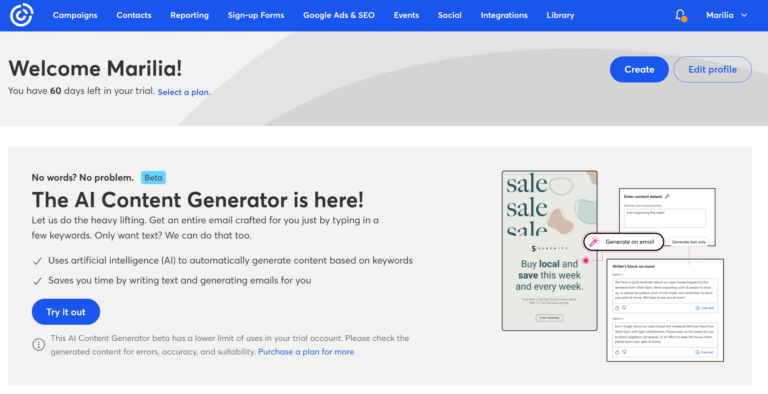
Constant Contact is also a fairly popular and well-known service with a simple editor and a whole bunch of email templates. However, their software is additionally designed for SMS campaigns. Also, thanks to the large number of metrics, you will be able to develop a wide range of segmentations.
Pros:
- Easy audience segmentation capabilities
- Multi-channel marketing options
3. MailerLite
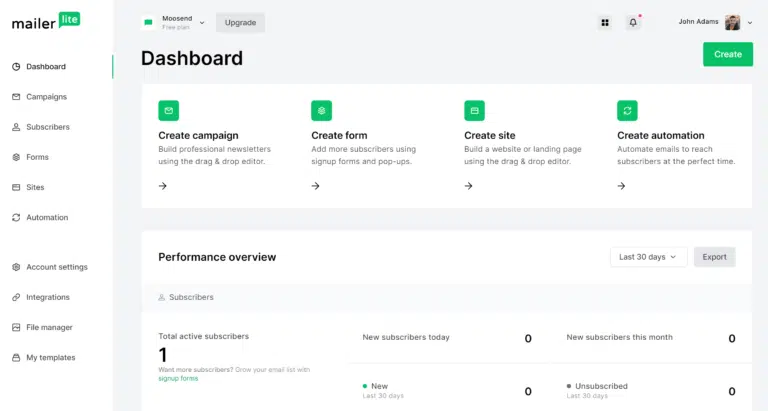
MailerLite has all the features and tools you need for a nonprofit email marketing company at a favorable and affordable price. The software stands out for its wide range of email styling options and advanced automation. These automations allow you to build welcome series, follow-up sequences, and other automated fundraising campaigns. It also has signup forms and landing pages to boost lead generation. Notable about the tool is the ability to sell digital products. This can be immensely valuable for nonprofit organizations raising money through relevant initiatives.
Pros:
- Special integration to process payments and donations
- Selling digital products
4. Mailchimp
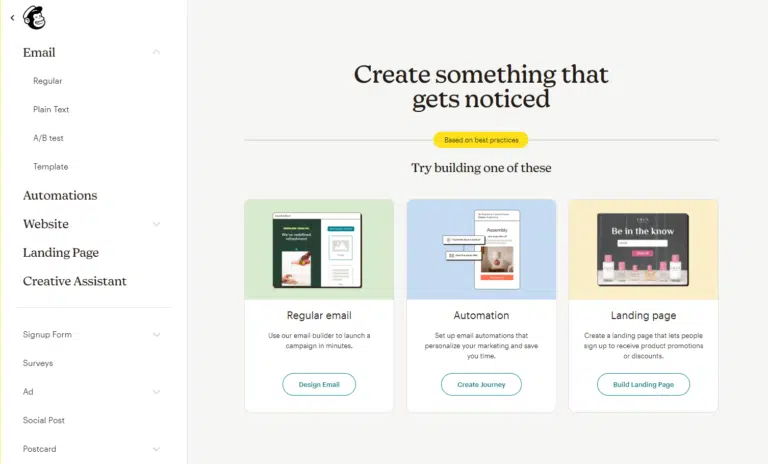
Mailchimp is an experienced professional in the email marketing software market that has many powerful, well-designed tools that will suit large email marketing companies and certain features for different charity emails. With Mailchimp’s comprehensive analytics, covering open rates, click-through rates, and geographic data, one can take full control of their strategy. Mailchimp integrates perfectly with CRM systems and donation platforms.
Pros:
- Broad template builder
- A lot of options for integration
- In-built CRM
5. AWeber
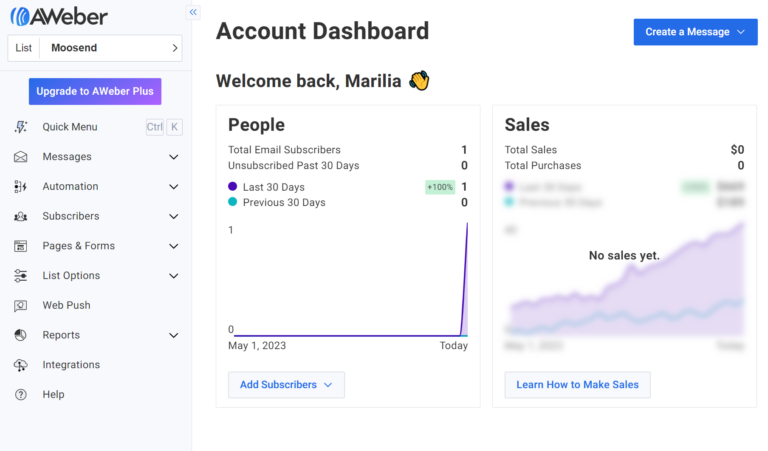
AWeber is a good fit for low-budget nonprofits that are just starting and have a small email list. It offers constant instant customer support, which is backed by an extensive knowledge base.
Pros:
- Advanced audience management options
- Constant customer support
6. GetResponse
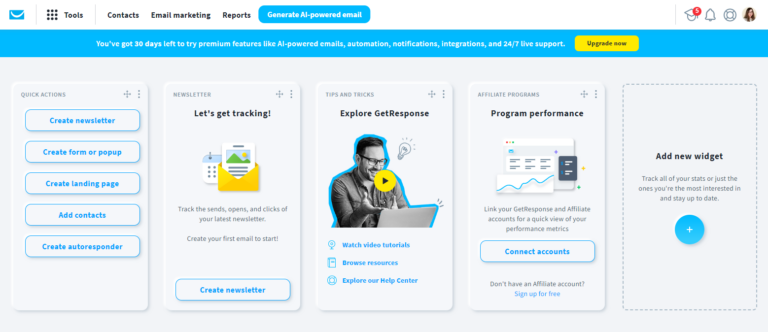
GetResponce is one of the competitive best email marketing solutions for nonprofit organizations. GetResponse will help you take your email marketing to the next level with a breakthrough strategy focused on top-notch A/B testing functionality. Based on this testing, you will be able to try many different email campaigns and choose the best one. GetResponse gives you peace of mind, as you can be sure that your email campaign is running efficiently on autopilot.
Pros:
- Design testing capabilities
- Marketing automation features
7. HubSpot
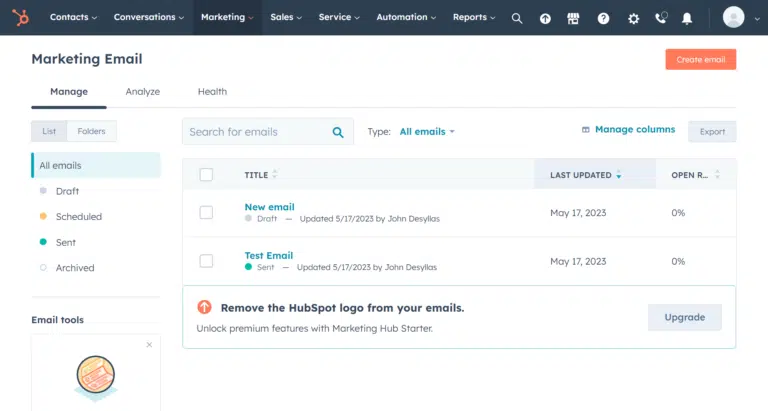
HubSpot includes a built-in CRM solution, which means you can cut costs on additional features. The platform is also known for its high deliverability rate. It features effective A/B testing that will help you attract more donors.
Pros:
- Broad automation capabilities
- Free tools available
Final Thoughts
Email marketing for nonprofit organizations is no less important than for e-commerce companies. As you can see, there is enough information and strategies on this topic to create a separate email marketing niche. The main thing is that you shouldn’t underestimate the benefits of email marketing, because its benefits can bring significant investments and more like-minded people to fulfill charitable goals.
FAQs
- How to choose the best email marketing software?
When it comes to email marketing software for nonprofits, the main thing is to identify the general requirements that you need from the planned email campaign. Based on the planned requirements and budget, you can already choose the best software with the necessary special features. Fortunately, there are plenty of such software on the market and, most importantly, they offer great discounts for nonprofits.
- How often should a nonprofit send newsletters?
According to MailChimp, the most popular frequency for nonprofit newsletters is once a month, although once a week is becoming more popular and effective. Our advice is that you shouldn’t send emails for no reason. The reason can be your new projects, updates, or seasonal events.
- How do nonprofits grow email lists?
The very first step to building your email list is to create signups for your newsletters in different places on your website and pop-ups. The main thing is that pop-ups shouldn’t be instant when the site is opened, so as not to discourage visitors. Read more about the forms of website pop-ups and other ways to grow your email list in the article.






